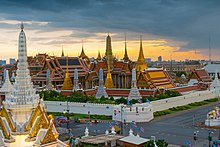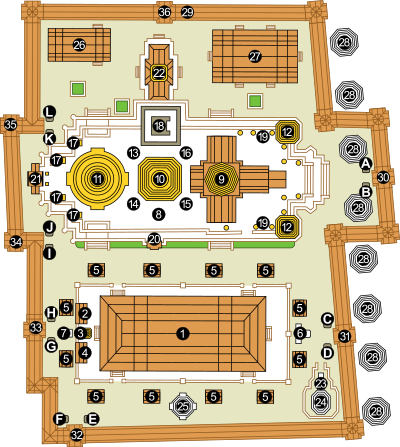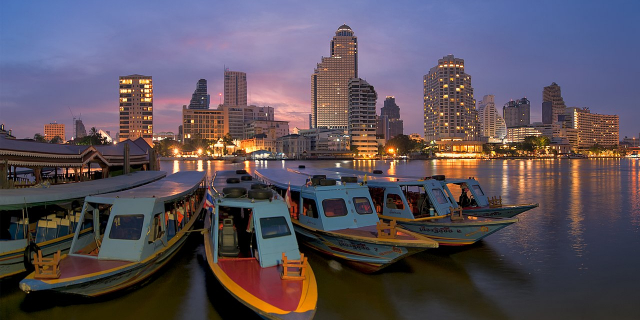วัดพระศรีรัตนศาสดาราม
( Wat Phra Kaew )
Wat Phra Kaew (Thai: วัดพระแก้ว, RTGS: Wat Phra Kaeo, pronounced [wát.pʰráʔ.kɛ̂ːw] ), commonly known in English as the Temple of the Emerald Buddha and officially as Wat Phra Si Rattana Satsadaram, is regarded as the most sacred Buddhist temple in Thailand. The complex consists of a number of buildings within the precincts of the Grand Palace in the historical centre of Bangkok. It houses the statue of the Emerald Buddha, which is venerated as the country's palladium.
Construction of the temple began in 1783 under the orders of Rama I, the first king of the Chakri dynasty. Since then, each successive king has been personally involved in adding, restoring and embellishing the temple during their reigns as a way of making religious ...Read more
Wat Phra Kaew (Thai: วัดพระแก้ว, RTGS: Wat Phra Kaeo, pronounced [wát.pʰráʔ.kɛ̂ːw] ), commonly known in English as the Temple of the Emerald Buddha and officially as Wat Phra Si Rattana Satsadaram, is regarded as the most sacred Buddhist temple in Thailand. The complex consists of a number of buildings within the precincts of the Grand Palace in the historical centre of Bangkok. It houses the statue of the Emerald Buddha, which is venerated as the country's palladium.
Construction of the temple began in 1783 under the orders of Rama I, the first king of the Chakri dynasty. Since then, each successive king has been personally involved in adding, restoring and embellishing the temple during their reigns as a way of making religious merit and glorifying the dynasty. Many important state and royal ceremonies are held within the temple each year, presided by the king in person and attended by government officials. This makes the temple the nation's preeminent place of worship and a national shrine for the monarchy and the state. Throughout the years, each king has donated sacred and valuable objects to the temple, making it a treasury as well.
The temple complex comprises various buildings for specific religious purposes built in a variety of Thai architectural styles, while still adhering to the traditional principles of Thai religious architecture.
 King Rama I founded the Chakri dynasty in 1782; he began construction of the Wat Phra Kaew a year later.
King Rama I founded the Chakri dynasty in 1782; he began construction of the Wat Phra Kaew a year later.When King Rama I made Bangkok the capital city of the Rattanakosin Kingdom on 6 April 1782, a suitable royal palace and temple was needed to legitimize the new Chakri dynasty. The King's reason for moving the capital city was a desire to distance himself from the previous regime of King Taksin, whom he had replaced as king of Siam. The old royal palace in Thonburi was small and sandwiched between two temples; Wat Arun and Wat Tai Talat, prohibiting further expansion.[1][2]
Rama I established the Grand Palace on the eastern bank of the Chao Phraya River, within the fortified city area now known as Rattanakosin Island. Traditionally, an area was always set aside within the palace compound for the construction of a royal temple or chapel for the king and the royal family's personal use. The temple (or wat) would have all the features of any regular Buddhist temple except for living quarters for monks. Surrounded on all sides by a wall, the temple would be a distinct space for worship separate from the king's residential space. As the temple would be built within the palace of the king, no monks would be lodged there. Instead, monks from various other temples would be invited to perform rituals and then leave. This was the case with Wat Mahathat, a royal chapel within the grounds of the royal palace at Sukhothai, Wat Phra Si Sanphet at Ayutthaya and Wat Arun in Thonburi.[2] Wat Phra Si Sanphet, built next to the royal palace of the king of Ayutthaya, particularly influenced the building of this new temple.[3]
 Wat Phra Kaew complex viewed from outside the walls of the Grand Palace
Wat Phra Kaew complex viewed from outside the walls of the Grand PalaceConstruction on the temple began in 1783. The temple was given the formal name Wat Phra Si Rattana Satsadaram, meaning "the temple containing the beautiful jewel of the monastery of the divine teacher".[4] The temple's main hall was the first building within the entire palace compound that was completed in masonry, while the king's residence was still made of wood. The temple complex was built in the northeastern corner of the Outer Court of the Grand Palace. In February/March 1785, the Emerald Buddha was transported with great ceremony from its former home at Wat Arun in Thonburi across the river to the Rattanakosin side and installed at its present position.[a] In 1786 Rama I gave Bangkok an official name as the new capital of Siam. Translated, the name mentions the temple and the Emerald Buddha itself: "The City of Angels, Great City, the Residence of the Emerald Buddha, the Great City of God Indra, Ayutthaya, the World Endowed with Nine Precious Gems, the Happy City Abounding in Great Royal Palaces which Resemble the Heavenly Abode Wherein Dwell the Reincarnated Gods, a City Given by Indra and Built by Vishvakarman".[8]
The temple has undergone many different periods of major renovations, beginning with the reigns of Rama III and Rama IV. Rama III started the rebuilding in 1831 for the 50th anniversary of Bangkok in 1832, while Rama IV's restoration was completed by Rama V in time for the Bangkok centennial celebrations in 1882. Further restoration took place under the reigns of Rama VII during Bangkok's 150th Anniversary in 1932 and of Rama IX for the 200th Anniversary in 1982.[9][10][2]
As the royal temple, Wat Phra Kaew continues to serve as the site of Buddhist religious rites undertaken by the king and the royal family, including major events such as coronations, royal ordinations and investiture of the supreme patriarch. The king or an appointee also attends annual ceremonies marking the major Buddhist holidays Visakha Puja, Asalha Puja and Magha Puja at the temple. Three times a year, the gold garments of the Emerald Buddha image are changed in a royal ceremony marking the change of the seasons. Annual rites are also held on Chakri Memorial Day, the Royal Ploughing Ceremony, the King's Birthday and Songkran (the traditional Thai new year).[11] On most other days, the temple, together with certain areas of the Grand Palace, is open to visitors, and they are among the country's best known tourist attractions.
Map of Wat Phra Kaew Ubosot and the Emerald Buddha
Ratchakoramanuson Hall
Phra Photithat Phiman
Ratchaphongsanuson Hall
Twelve sala
Chao Mae Kuan Im
The Hermit
Than Phaithi
Prasat Phra Thep Bidon
Phra Mondop
Phra Si Rattana Chedi
Phra Suvarnachedi
Monument to Rama I, II and III
Monument to Rama IV
Monument to Rama V
Monument to Rama VI, VII, VIII and IX
Phra Chedi Songkhrueang
Model of Angkor Wat
Mythological figures
Southern porch
Western porch
Phra Sawet Kudakhan Wihan Yot
Ho Phra Khanthararat
Phra Mondop Yot Prang
Bell Tower
Ho Phra Nak
Ho Phra Monthiantham
Row of eight prang
Ramakien gallery
Gate No. 1, Koei Sadet (front)
Gate No. 2, Na Wua
Gate No. 3, Phra Sri Ratanasatsada
Gate No. 4, Hermit
Gate No. 5, Koei Sadet (rear)
Gate No. 6, Sanam Chai
Gate No. 7, Wihan Yot
Suriyaphop
Intarachit
Mangkonkan
Wirunhok
Thotsakhirithon
Thotsakhiriwan
Chakkrawat
Atsakanmala
Thotsakan
Sahatsadecha
Maiyarap
Wirunchambang
Ubosot and the Emerald Buddha
Ratchakoramanuson Hall
Phra Photithat Phiman
Ratchaphongsanuson Hall
Twelve sala
Chao Mae Kuan Im
The Hermit
Than Phaithi
Prasat Phra Thep Bidon
Phra Mondop
Phra Si Rattana Chedi
Phra Suvarnachedi
Monument to Rama I, II and III
Monument to Rama IV
Monument to Rama V
Monument to Rama VI, VII, VIII and IX
Phra Chedi Songkhrueang
Model of Angkor Wat
Mythological figures
Southern porch
Western porch
Phra Sawet Kudakhan Wihan Yot
Ho Phra Khanthararat
Phra Mondop Yot Prang
Bell Tower
Ho Phra Nak
Ho Phra Monthiantham
Row of eight prang
Ramakien gallery
Gate No. 1, Koei Sadet (front)
Gate No. 2, Na Wua
Gate No. 3, Phra Sri Ratanasatsada
Gate No. 4, Hermit
Gate No. 5, Koei Sadet (rear)
Gate No. 6, Sanam Chai
Gate No. 7, Wihan Yot
Suriyaphop
Intarachit
Mangkonkan
Wirunhok
Thotsakhirithon
Thotsakhiriwan
Chakkrawat
Atsakanmala
Thotsakan
Sahatsadecha
Maiyarap
Wirunchambang
Cite error: There are <ref group=lower-alpha> tags or {{efn}} templates on this page, but the references will not show without a {{reflist|group=lower-alpha}} template or {{notelist}} template (see the help page).


























Add new comment